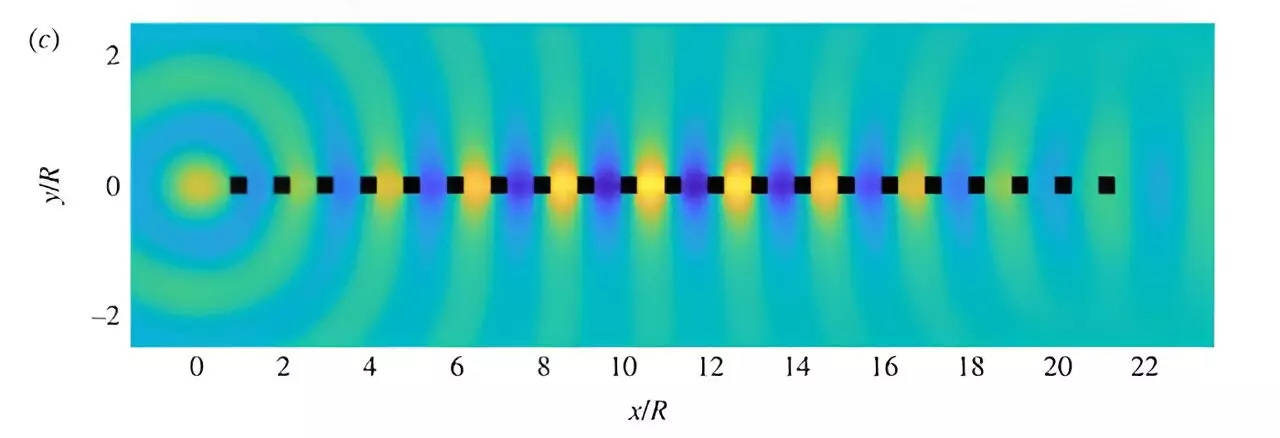Recent advancements in computational materials science have come to fruition through the development of TMATSOLVER, a state-of-the-art software package created by researchers from Macquarie University. This new tool is poised to reshape the landscape of metamaterial design by providing researchers with the ability to simulate complex interactions of waves—whether they be sound, light, or water—with intricate arrangements of particles. Published in the prestigious Proceedings of the Royal Society A on June 19, 2024, these findings promise to enhance the speed and accuracy of metamaterial development, a field that has garnered significant attention due to the potential of such materials to manipulate waves in extraordinary ways.
At the heart of TMATSOLVER is the transition matrix or T-matrix, a mathematical construct that encapsulates all information necessary to describe how an object scatters waves. Although the concept of the T-matrix has been utilized since the 1960s, the latest iteration included in TMATSOLVER has achieved remarkable advancements that allow for the modeling of larger particles with complex geometrical shapes. Lead author Dr. Stuart Hawkins from Macquarie University’s Department of Mathematics and Statistics emphasizes the ability to tackle configurations that were previously insurmountable. By capitalizing on multipole expansion techniques, researchers have opened doors to model interactions more accurately, with higher fidelity than ever before.
Rather than just extrapolating from simplified models, TMATSOLVER enables researchers to delve into the intricacies of metamaterial formation, where the collective behavior of particles matters significantly. This tool bridges the gap between theory and application, allowing for a more thorough investigation of how particles with anisotropic properties can function collectively. The implications for various scientific disciplines are profound, paving the way for innovations in technology and engineering.
The development of this innovative software was a collaborative effort, involving mathematicians from prestigious institutions such as the University of Adelaide, Imperial College London, and the University of Augsburg. Co-author Dr. Luke Bennetts noted the significance of TMATSOLVER in eliminating computational bottlenecks that hinder research progress. The efficiency gained allows scientists to conduct complex metamaterial experiments without the historical frustrations of numerical computation delays.
The software’s capacity for handling multifaceted geometrical configurations was put to the test through a series of example problems, showcasing its versatility. These demonstrations included high-contrast square particles and periodic structures designed to manipulate wave speeds. The unique properties enabled by metamaterials can yield extraordinary applications—from super-lenses capable of observing minute details to innovative devices that absorb sound or electromagnetic waves.
As the global market for metamaterials continues to expand, the findings from this research are set to accelerate progress in various sectors. Metamaterials, engineered to exhibit properties not found in nature, hold transformative potential. From invisibility cloaks to advanced energy-harvesting technologies, the implications of TMATSOLVER are not limited to academic curiosity but extend into commercial applications and technological advancements.
Professor Lucy Marshall, Executive Dean of the Faculty of Science and Engineering at Macquarie University, highlights the role of TMATSOLVER as a critical facilitator for scientific breakthroughs in metamaterial design. She suggests that innovative computational methods will usher in a new era of materials science, enhancing our understanding of wave interactions and the development of advanced materials.
TMATSOLVER represents a significant leap forward in modeling wave scattering phenomena, making it easier than ever for researchers to experiment with metamaterials. As the dynamics of wave-particle interactions are better elucidated, the suite of applications for such materials promises to revolutionize the ways we interact with electromagnetic and acoustic waves. The ongoing collaboration among global institutions through projects like this highlights a vibrant future for materials science, where computational power harmonizes with innovative design to push the boundaries of what is conceivable. As TMATSOLVER gains traction, its role in shaping the next generation of metamaterials will undoubtedly be crucial.

